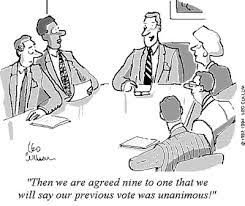How are consensus decisions developed?
Consensus becomes possible within groups that are committed to honoring each person’s contribution. The collaborative problem solving process involves a shared commitment to listen  respectfully to each other and the choice to allow each unique perspective to inform the whole view. A consensus-building group will make a deliberate effort to find and build upon what is shared. Respectful dialogue and careful deliberation allow everyone to bring their ideas to the table. Trained facilitators design and manage collaborative problem solving processes to help a group of people consider all aspects of a problem and potential solutions before moving forward. Those who think differently are provided the chance to be heard. Sometimes people just want to see an idea given consideration. Adding an alternative to the list of options being evaluated may make those individuals feel their perspectives and concerns have been acknowledged. Similarly, adding a criterion to reflect specific concerns will help people come on board.
respectfully to each other and the choice to allow each unique perspective to inform the whole view. A consensus-building group will make a deliberate effort to find and build upon what is shared. Respectful dialogue and careful deliberation allow everyone to bring their ideas to the table. Trained facilitators design and manage collaborative problem solving processes to help a group of people consider all aspects of a problem and potential solutions before moving forward. Those who think differently are provided the chance to be heard. Sometimes people just want to see an idea given consideration. Adding an alternative to the list of options being evaluated may make those individuals feel their perspectives and concerns have been acknowledged. Similarly, adding a criterion to reflect specific concerns will help people come on board.
What can be done if consensus proves elusive?
There are options available to help a group struggling to find consensus, including:
- Allowing those who object time to share their concerns about the direction a group is heading will often reveal that they see aspects of the conversation that others are not acknowledging. Slowing down to listen to everyone will often change the shared understanding and everyone will agree to a modification that can be supported by all.
- Dividing a large topic into smaller pieces may help. Isolating and reaching agreement on each smaller topic can often isolate a slight disconnect and allow people to come together. In this case, the specific smaller decisions should be documented along the way.
- Often, simply documenting the words used to articulate a decision, and then “word-smithing” the statement will help identify sticking points. An apparently trivial word change that is meaningful to one person may bring everyone together into agreement.
- Many times, taking some time off will help. Those with objections to a situation where they feel outnumbered often dig their heels in, without even realizing they are doing it. Given some time to think, they may realize they are standing up for something that is not that important to them. That time off might mean rearranging the topics on the agenda. For on-going groups, rescheduling a decision to a future meeting may work as well.
- Rather than developing a conclusion, a group might decide to communicate the full range of concerns to the decision maker. The group might reach consensus to communicate a result that looks this: “The participants were not able to reach consensus on a list of the top five concerns, but agreed to transmit all concerns expressed by one or more of us. The entire list includes the following: …” Such a result honors the group’s commitment to work by consensus.
Is consensus ever the wrong approach?
Consensus may not be necessary. If a meeting sponsor is expecting to use a group of people as a sounding board (at the Consult level of the International Associate for Public Participation’s Spectrum, for example), consensus may not be necessary or even helpful. For example, if a key perspective is not present at the session, portraying the results of the session as a consensus product could cause more harm than good.
Who decides when to try for consensus? A choice to try for consensus through collaborative problem solving should be deliberate on the part of the group. Facilitators will often recommend agreement on a back-up decision making process as well. Interestingly, once committed to the concept, few groups fail.
